HONDA ACCORD HYBRID 2023 Owners Manual
Manufacturer: HONDA, Model Year: 2023, Model line: ACCORD HYBRID, Model: HONDA ACCORD HYBRID 2023Pages: 627, PDF Size: 23 MB
Page 391 of 627
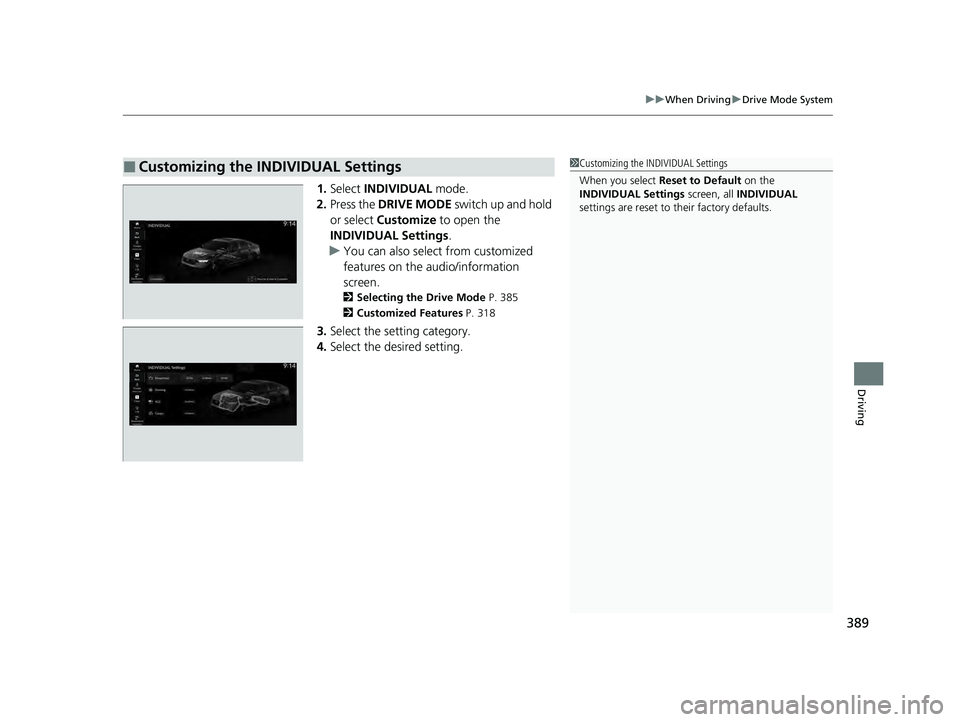
389
uuWhen Driving uDrive Mode System
Driving
1. Select INDIVIDUAL mode.
2. Press the DRIVE MODE swi t ch up an d h old
or select Customize to open the
INDIVIDUAL Settings .
u You can also select from customized
features on the audio/information
screen.
2 Selecting the Drive Mode P. 385
2 Customized Features P. 318
3.Select the setting category.
4. Select the desired setting.
■Customizing the INDIVIDUAL Settings1Customizing the INDIVIDUAL Settings
When you select Reset to Default on the
INDIVIDUAL Settings screen, all INDIVIDUAL
settings are reset to their factory defaults.
23 ACCORD 4D US HEV MAP-3130B6000.book 389 ページ 2022年10月13日 木曜日 午後4時50分
Page 392 of 627
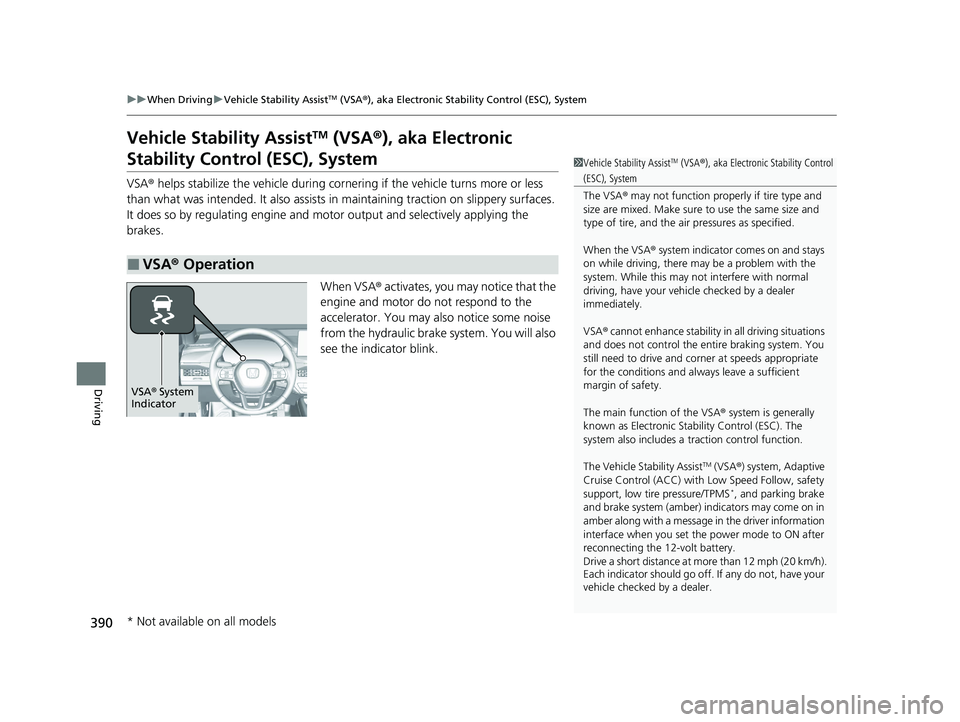
390
uuWhen Driving uVehicle Stability AssistTM (VSA ®), aka Electronic Stability Control (ESC), System
Driving
Vehicle Stability AssistTM (VSA ®), aka Electronic
Stability Control (ESC), System
VSA ® helps stabilize the vehicle during cornering if the vehicle turns more or less
than what was intended. It also assists in maintaining traction on slippery surfaces.
It does so by regulating engine and motor output and selectively applying the
brakes.
When VSA® activates, you may notice that the
engine and motor do not respond to the
accelerator. You may also notice some noise
from the hydraulic brake sy stem. You will also
see the indicator blink.
■VSA ® Operation
1 Vehicle Stability AssistTM (VSA ®), aka Electronic Stability Control
(ESC), System
The VSA ® may not function properl y if tire type and
size are mixed. Make sure to use the same size and
type of tire, and the air pressures as specified.
When the VSA ® system indicator comes on and stays
on while driving, there may be a problem with the
system. While this may not interfere with normal
driving, have your vehi cle checked by a dealer
immediately.
VSA ® cannot enhance stability in all driving situations
and does not control the entire braking system. You
still need to drive and corner at speeds appropriate
for the conditions and always leave a sufficient
margin of safety.
The main function of the VSA ® system is generally
known as Electronic Stab ility Control (ESC). The
system also includes a traction control function.
The Vehicle Stability Assist
TM (VSA ®) system, Adaptive
Cruise Control (ACC) with Low Speed Follow, safety
support, low tire pressure/TPMS
*, and parking brake
and brake system (amber) indicators may come on in
amber along with a message in the driver information
interface when you set the power mode to ON after
reconnecting the 12-volt battery.
Drive a short distance at mo re than 12 mph (20 km/h).
Each indicator should go off. If any do not, have your
vehicle checked by a dealer.
VSA ® System
Indicator
* Not available on all models
23 ACCORD 4D US HEV MAP-3130B6000.book 390 ページ 2022年10月13日 木曜日 午後4時50分
Page 393 of 627
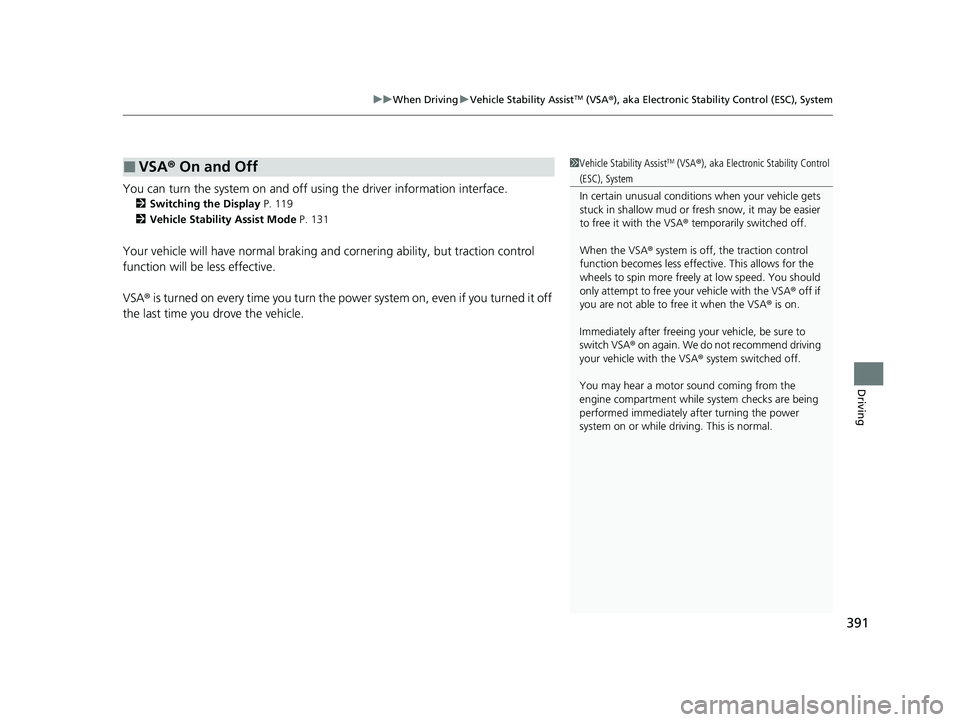
391
uuWhen Driving uVehicle Stability AssistTM (VSA ®), aka Electronic Stability Control (ESC), System
Driving
You can turn the system on and off using the driver information interface.
2 Switching the Display P. 119
2 Vehicle Stability Assist Mode P. 131
Your vehicle will have normal braking and cornering ability, but traction control
function will be less effective.
VSA ® is turned on every time you turn the pow er system on, even if you turned it off
the last time you drove the vehicle.
■VSA ® On and Off1 Vehicle Stability AssistTM (VSA® ), aka Electronic Stability Control
(ESC), System
In certain unusual conditions when your vehicle gets
stuck in shallow mud or fr esh snow, it may be easier
to free it with the VSA ® temporarily switched off.
When the VSA ® system is off, the traction control
function becomes less effective. This allows for the
wheels to spin more freely at low speed. You should
only attempt to free your vehicle with the VSA ® off if
you are not able to free it when the VSA ® is on.
Immediately after freeing your vehicle, be sure to
switch VSA ® on again. We do not recommend driving
your vehicle with the VSA ® system switched off.
You may hear a motor sound coming from the
engine compartment while system checks are being
performed immediately after turning the power
system on or while driving. This is normal.
23 ACCORD 4D US HEV MAP-3130B6000.book 391 ページ 2022年10月13日 木曜日 午後4時50分
Page 394 of 627
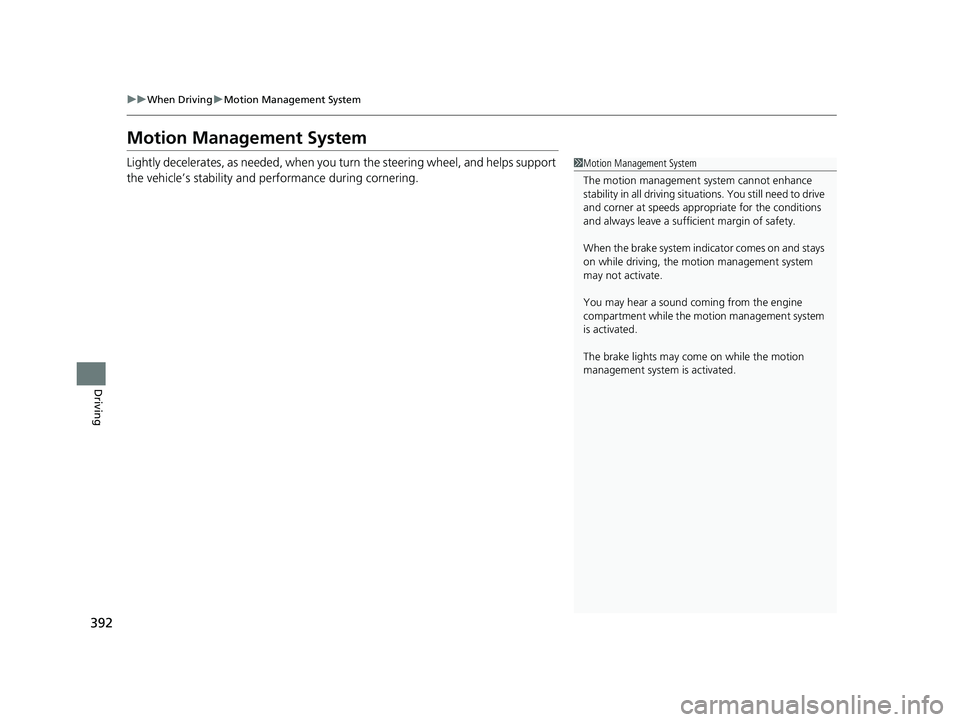
392
uuWhen Driving uMotion Management System
Driving
Motion Management System
Lightly decelerates, as needed, when you turn the steering wheel, and helps support
the vehicle’s stability and pe rformance during cornering.1Motion Management System
The motion management system cannot enhance
stability in all driving situat ions. You still need to drive
and corner at speeds appr opriate for the conditions
and always leave a sufficient margin of safety.
When the brake system indicator comes on and stays
on while driving, the mo tion management system
may not activate.
You may hear a sound coming from the engine
compartment while the motion management system
is activated.
The brake lights may come on while the motion
management system is activated.
23 ACCORD 4D US HEV MAP-3130B6000.book 392 ページ 2022年10月13日 木曜日 午後4時50分
Page 395 of 627
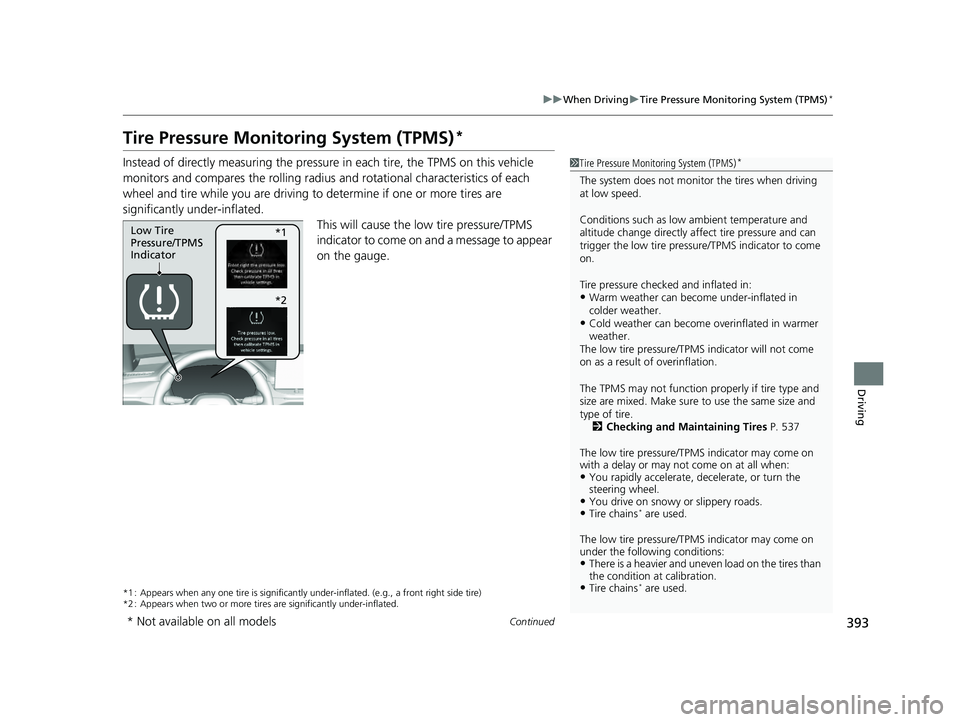
393
uuWhen Driving uTire Pressure Monitoring System (TPMS)*
Continued
Driving
Tire Pressure Monitoring System (TPMS)*
Instead of directly measuring the pressure in each tire, the TPMS on this vehicle
monitors and compares the rolling radius and rotational characteristics of each
wheel and tire while you are driving to determine if one or more tires are
significantly under-inflated. This will cause the low tire pressure/TPMS
indicator to come on and a message to appear
on the gauge.
*1 : Appears when any one tire is significantly under-inflated. (e.g., a front right side tire)
*2 : Appears when two or more tire s are significantly under-inflated.
1Tire Pressure Monitoring System (TPMS)*
The system does not monitor the tires when driving
at low speed.
Conditions such as low ambient temperature and
altitude change directly affect tire pressure and can
trigger the low tire pressure/TPMS indicator to come
on.
Tire pressure checked and inflated in:
•Warm weather can beco me under-inflated in
colder weather.
•Cold weather can become overinflated in warmer
weather.
The low tire pressure/TPMS indicator will not come
on as a result of overinflation.
The TPMS may not function pr operly if tire type and
size are mixed. Make sure to use the same size and
type of tire. 2 Checking and Maintaining Tires P. 537
The low tire pressure/TPMS indicator may come on
with a delay or may not come on at all when:
•You rapidly accelerate, decelerate, or turn the
steering wheel.
•You drive on snowy or slippery roads.•Tire chains* are used.
The low tire pressure/TPMS indicator may come on
under the following conditions:
•There is a heavier and uneve n load on the tires than
the condition at calibration.
•Tire chains* are used.
Low Tire
Pressure/TPMS
Indicator*1
*2
* Not available on all models
23 ACCORD 4D US HEV MAP-3130B6000.book 393 ページ 2022年10月13日 木曜日 午後4時50分
Page 396 of 627
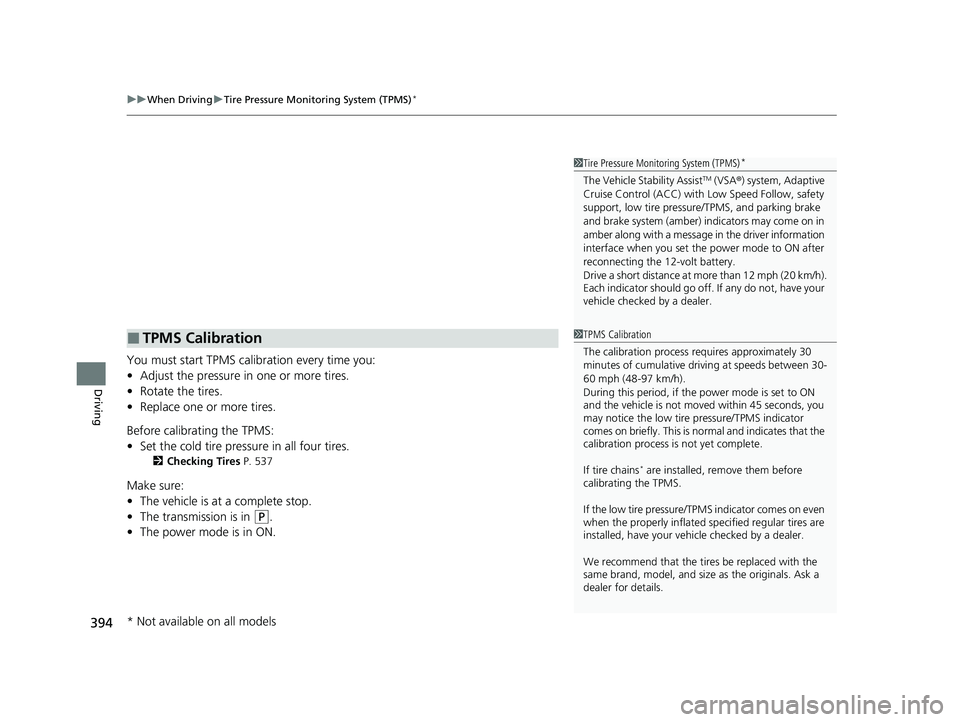
uuWhen Driving uTire Pressure Monitoring System (TPMS)*
394
Driving
You must start TPMS calibration every time you:
• Adjust the pressure in one or more tires.
• Rotate the tires.
• Replace one or more tires.
Before calibrating the TPMS:
• Set the cold tire pressu re in all four tires.
2Checking Tires P. 537
Make sure:
•The vehicle is at a complete stop.
• The transmission is in
(P.
• The power mode is in ON.
■TPMS Calibration
1Tire Pressure Monitoring System (TPMS)*
The Vehicle Stability AssistTM (VSA ®) system, Adaptive
Cruise Control (ACC) with Low Speed Follow, safety
support, low tire pressure /TPMS, and parking brake
and brake system (amber) indicators may come on in
amber along with a message in the driver information
interface when you set the power mode to ON after
reconnecting the 12-volt battery.
Drive a short distance at mo re than 12 mph (20 km/h).
Each indicator should go off. If any do not, have your
vehicle checked by a dealer.
1 TPMS Calibration
The calibration process requires approximately 30
minutes of cumulative driv ing at speeds between 30-
60 mph (48-97 km/h).
During this period, if the power mode is set to ON
and the vehicle is not moved within 45 seconds, you
may notice the low tire pressure/TPMS indicator
comes on briefly. This is no rmal and indicates that the
calibration process is not yet complete.
If tire chains
* are installed, remove them before
calibrating the TPMS.
If the low tire pressure/TPMS indicator comes on even
when the properly inflated specified regular tires are
installed, have your vehicle checked by a dealer.
We recommend that the tires be replaced with the
same brand, model, and size as the originals. Ask a
dealer for details.
* Not available on all models
23 ACCORD 4D US HEV MAP-3130B6000.book 394 ページ 2022年10月13日 木曜日 午後4時50分
Page 397 of 627
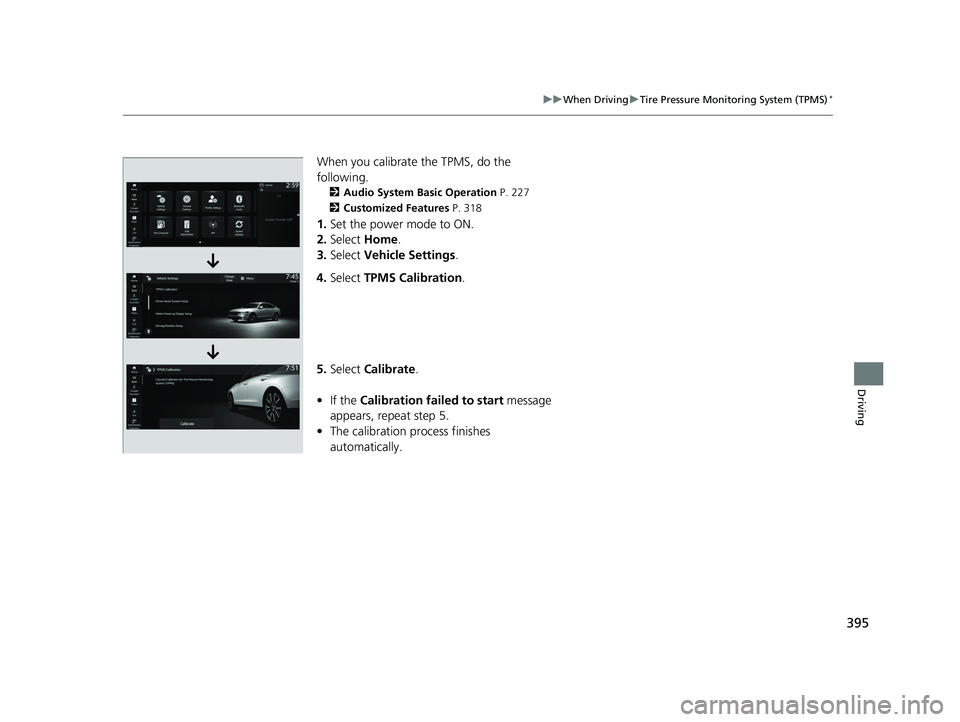
395
uuWhen Driving uTire Pressure Monitoring System (TPMS)*
Driving
When you calibrate the TPMS, do the
following.
2 Audio System Basic Operation P. 227
2 Customized Features P. 318
1.Set the power mode to ON.
2. Select Home.
3. Select Vehicle Settings.
4. Select TPMS Calibration .
5. Select Calibrate .
• If the Calibration failed to start message
appears, repeat step 5.
• The calibration process finishes
automatically.
23 ACCORD 4D US HEV MAP-3130B6000.book 395 ページ 2022年10月13日 木曜日 午後4時50分
Page 398 of 627
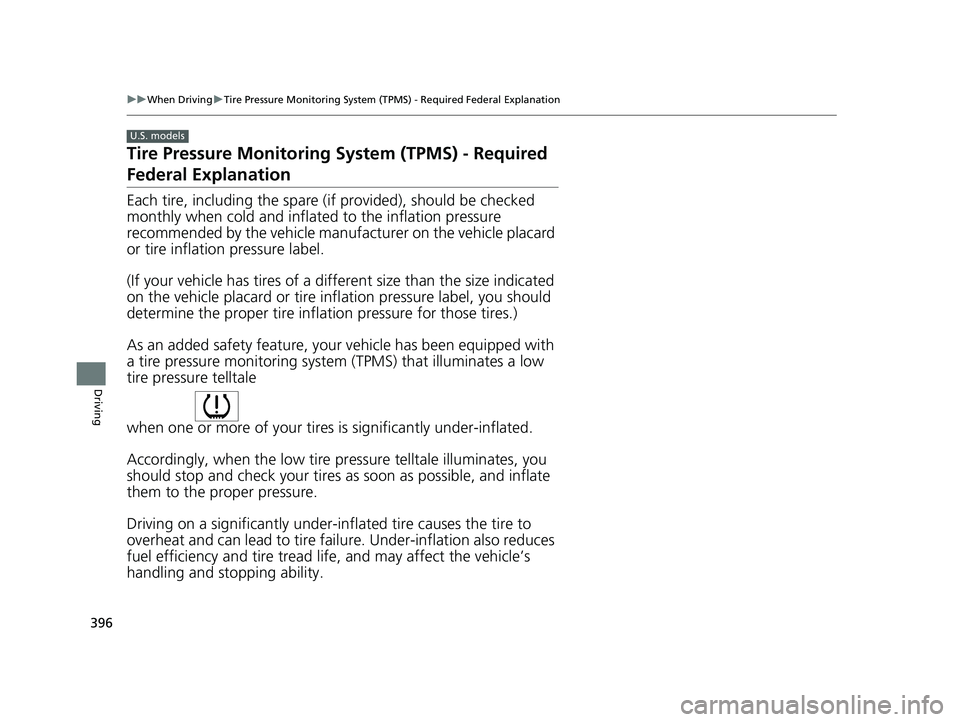
396
uuWhen Driving uTire Pressure Monitoring System (TPMS) - Required Federal Explanation
Driving
Tire Pressure Monitoring System (TPMS) - Required
Federal Explanation
Each tire, including the spare (i f provided), should be checked
monthly when cold and inflated to the inflation pressure
recommended by the vehicle manufacturer on the vehicle placard
or tire inflation pressure label.
(If your vehicle has tires of a different size than the size indicated
on the vehicle placard or tire infl ation pressure label, you should
determine the proper tire inflat ion pressure for those tires.)
As an added safety feature, your vehicle has been equipped with
a tire pressure monitoring system (TPMS) that illuminates a low
tire pressure telltale
when one or more of your tire s is significantly under-inflated.
Accordingly, when the low tire pr essure telltale illuminates, you
should stop and check your tires as soon as possible, and inflate
them to the proper pressure.
Driving on a significantly under-in flated tire causes the tire to
overheat and can lead to tire fail ure. Under-inflation also reduces
fuel efficiency and tire tread li fe, and may affect the vehicle’s
handling and stopping ability.
U.S. models
23 ACCORD 4D US HEV MAP-3130B6000.book 396 ページ 2022年10月13日 木曜日 午後4時50分
Page 399 of 627
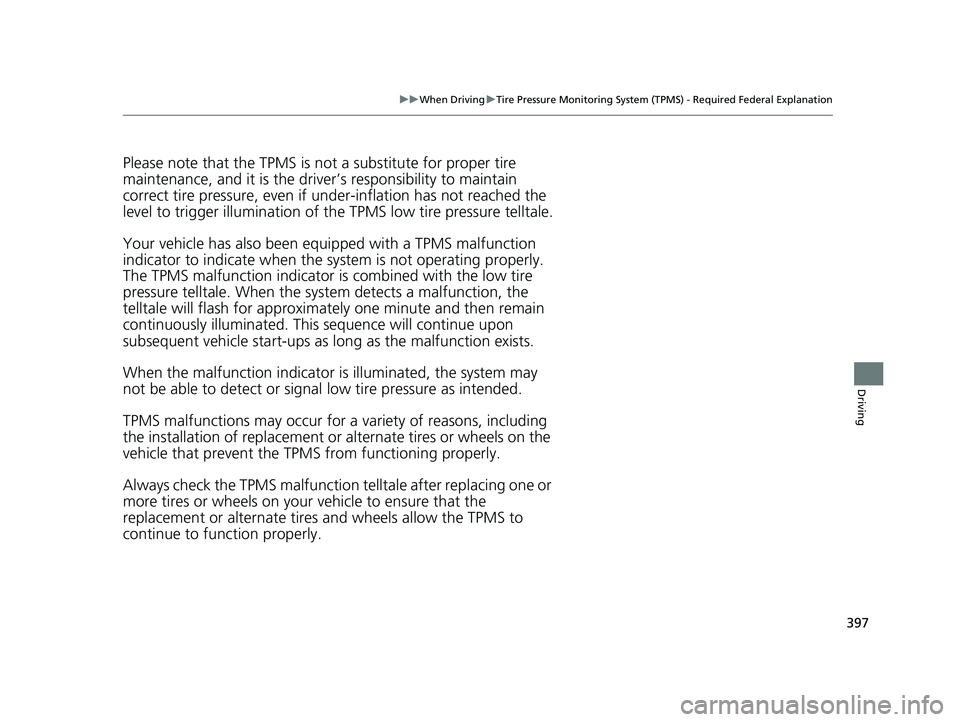
397
uuWhen Driving uTire Pressure Monitoring System (TPMS) - Required Federal Explanation
Driving
Please note that the TPMS is not a substitute for proper tire
maintenance, and it is the driver ’s responsibility to maintain
correct tire pressure, even if un der-inflation has not reached the
level to trigger illumination of th e TPMS low tire pressure telltale.
Your vehicle has also been equi pped with a TPMS malfunction
indicator to indicate when the system is not operating properly.
The TPMS malfunction indicator is combined with the low tire
pressure telltale. When the syst em detects a malfunction, the
telltale will flash fo r approximately one minute and then remain
continuously illumina ted. This sequence will continue upon
subsequent vehicle start-ups as long as the malfunction exists.
When the malfunction indicator is illuminated, the system may
not be able to detect or signal low tire pressure as intended.
TPMS malfunctions may occur for a variety of reasons, including
the installation of replacement or alternate tires or wheels on the
vehicle that prevent the TPMS from functioning properly.
Always check the TPMS malfunction telltale after replacing one or
more tires or wheels on your vehicle to ensure that the
replacement or alternate tires and wheels allow the TPMS to
continue to function properly.
23 ACCORD 4D US HEV MAP-3130B6000.book 397 ページ 2022年10月13日 木曜日 午後4時50分
Page 400 of 627
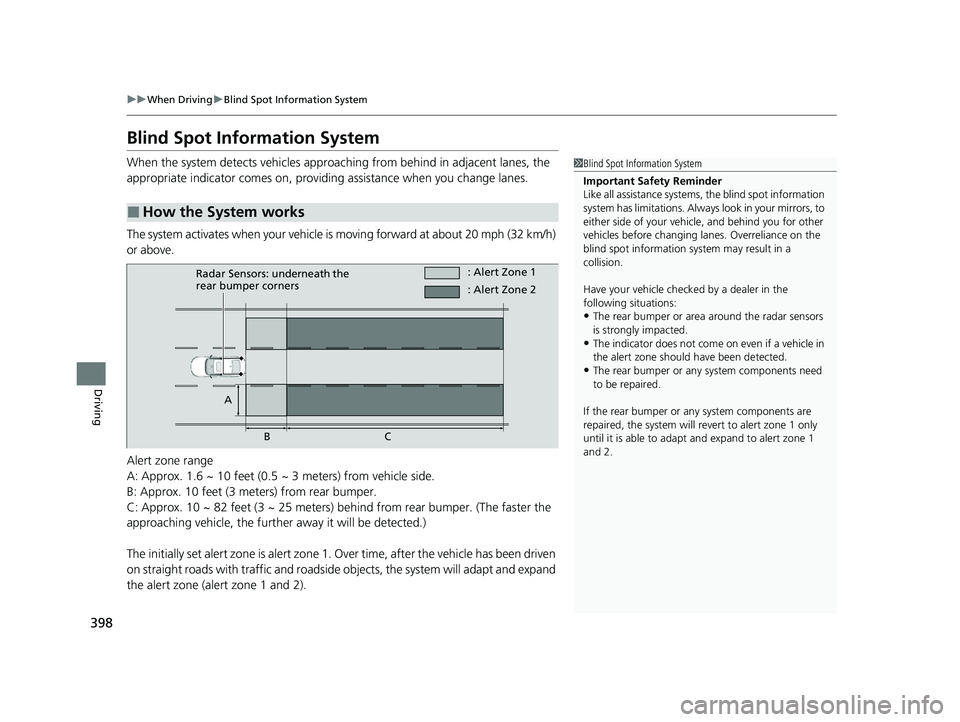
398
uuWhen Driving uBlind Spot Information System
Driving
Blind Spot Information System
When the system detects vehi cles approaching from behind in adjacent lanes, the
appropriate indicator comes on, providin g assistance when you change lanes.
The system activates when your vehicle is moving forward at about 20 mph (32 km/h)
or above.
Alert zone range
A: Approx. 1.6 ~ 10 feet (0.5 ~ 3 meters) from vehicle side.
B: Approx. 10 feet (3 meters) from rear bumper.
C: Approx. 10 ~ 82 feet (3 ~ 25 meters) behind from rear bumper. (The faster the
approaching vehicle, the furthe r away it will be detected.)
The initially set alert zone is alert zone 1. Over time, after the vehicle has been driven
on straight roads with traffic and roadside objects, the system will adapt and expand
the alert zone (alert zone 1 and 2).
■How the System works
1 Blind Spot Information System
Important Safety Reminder
Like all assistance systems, the blind spot information
system has limitations. Always look in your mirrors, to
either side of your vehicle, and behind you for other
vehicles before changing la nes. Overreliance on the
blind spot information sy stem may result in a
collision.
Have your vehicle checked by a dealer in the
following situations:
•The rear bumper or area around the radar sensors
is strongly impacted.
•The indicator does not come on even if a vehicle in
the alert zone should have been detected.
•The rear bumper or any system components need
to be repaired.
If the rear bumper or any system components are
repaired, the system will re vert to alert zone 1 only
until it is able to adapt and expand to alert zone 1
and 2.
Radar Sensors: underneath the
rear bumper corners : Alert Zone 1
A BC : Alert Zone 2
23 ACCORD 4D US HEV MAP-3130B6000.book 398 ページ 2022年10月13日 木曜日 午後4時50分